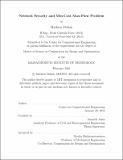| dc.contributor.advisor | Saurabh Amin. | en_US |
| dc.contributor.author | Dahan, Mathieu | en_US |
| dc.contributor.other | Massachusetts Institute of Technology. Computation for Design and Optimization Program. | en_US |
| dc.date.accessioned | 2016-09-30T19:35:23Z | |
| dc.date.available | 2016-09-30T19:35:23Z | |
| dc.date.copyright | 2016 | en_US |
| dc.date.issued | 2016 | en_US |
| dc.identifier.uri | http://hdl.handle.net/1721.1/104555 | |
| dc.description | Thesis: S.M., Massachusetts Institute of Technology, Computation for Design and Optimization Program, 2016. | en_US |
| dc.description | Cataloged from PDF version of thesis. | en_US |
| dc.description | Includes bibliographical references (pages 92-93). | en_US |
| dc.description.abstract | Network optimization has widely been studied in the literature for a variety of design and operational problems. This has resulted in the development of computational algorithms for the study of classical operations research problems such as the maximum flow problem, the shortest path problem, and the network interdiction problem. However, in environments where network components are subject to adversarial failures, the network operator needs to strategically allocate at least some of her resources (e.g., link capacities, network flows, etc.) while accounting for the presence of a strategic adversary. This motivates the study of network security games. This thesis considers a class of network security games on flow networks, and focuses on utilizing well-known results in network optimization toward the characterization of Nash equilibria of this class of games. Specifically, we consider a 2-player strategic game for network routing under link disruptions. Player 1 (defender) routes flow through a network to maximize her value of effective flow while facing transportation costs. Player 2 (attacker) simultaneously disrupts one or more links to maximize her value of lost flow but also faces cost of disrupting links. Linear programming duality and the Max-Flow Min-Cut Theorem are applied to obtain properties that are satisfied in any Nash equilibrium. Using graph theoretic arguments, we give a characterization of the support of the equilibrium strategies. Finally, we study the conditions under which these results extend to a revised version of the game where both players face budget constraints. Thus, our contribution can be viewed as a generalization of the classical minimum cost maximum flow problem and the minimum cut problem to adversarial environments. | en_US |
| dc.description.statementofresponsibility | by Mathieu Dahan. | en_US |
| dc.format.extent | 93 pages | en_US |
| dc.language.iso | eng | en_US |
| dc.publisher | Massachusetts Institute of Technology | en_US |
| dc.rights | M.I.T. theses are protected by copyright. They may be viewed from this source for any purpose, but reproduction or distribution in any format is prohibited without written permission. See provided URL for inquiries about permission. | en_US |
| dc.rights.uri | http://dspace.mit.edu/handle/1721.1/7582 | en_US |
| dc.subject | Computation for Design and Optimization Program. | en_US |
| dc.title | Network security and min-cost max-flow problem | en_US |
| dc.type | Thesis | en_US |
| dc.description.degree | S.M. | en_US |
| dc.contributor.department | Massachusetts Institute of Technology. Computation for Design and Optimization Program | |
| dc.identifier.oclc | 958628310 | en_US |
